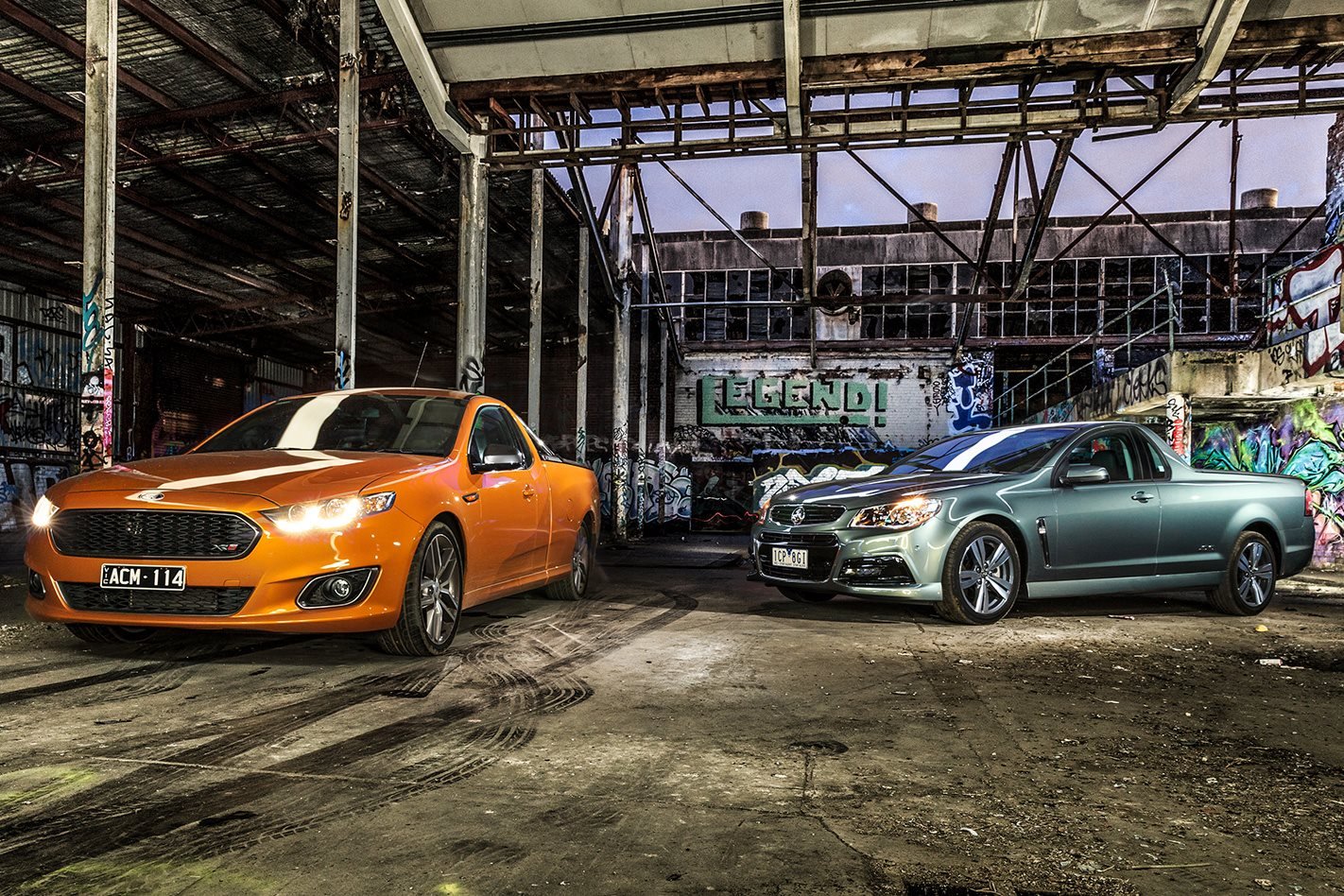We live in a clever country. Seriously, are you aware just how many great inventions this little nation has been responsible for?
Australians have revolutionised warfare through the invention of the tank and the underwater missile, created a number of medical breakthroughs like the pacemaker, ultrasound and the bionic ear, and have been responsible for major advances in aviation safety thanks to the black box flight recorder and inflatable escape slide.
Not only are we good at inventing stuff, our good old Aussie ingenuity allows us to think up all sorts of unique applications for the things we create. What other country would think of combining two of its greatest inventions – cask wine and the Hills Hoist – to produce that game beloved of university students everywhere, Goon of Fortune?
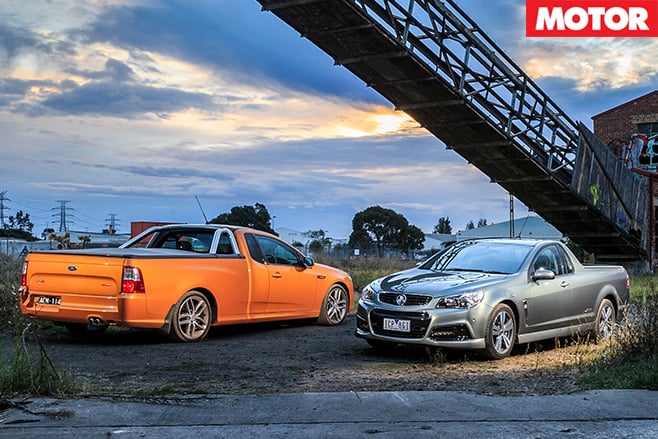
When Ford Australia designer, Louis (Lewis) Bandt, created the first coupe-utility back in 1934 he had little idea he would be laying the foundations for what would essentially become Australia’s sports car, with performance to burn, room for two and a bloody big boot.
Bandt’s brief was simply to answer the needs of Victoria’s farming community, a Gippsland farmer’s wife famously writing to Ford asking it to consider making a vehicle that would allow passengers to travel to church in comfort on Sunday yet still be able to cart the pigs to the market on Monday.
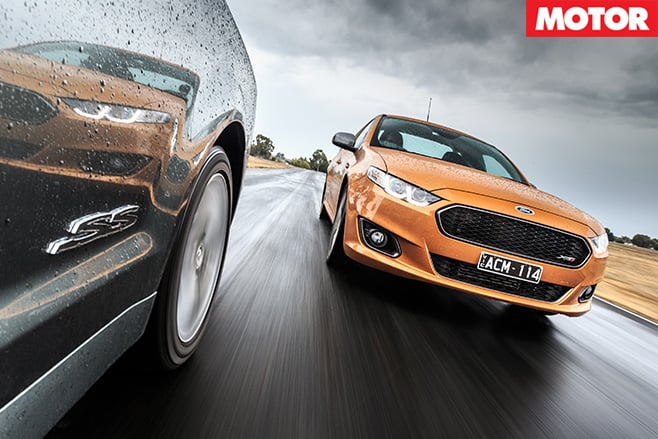
Anyway, the performance ute’s brilliant combination of pace and practicality has made it a crucial part of the local enthusiast scene, and the release of the FG X Falcon provided the perfect excuse for a traditional red vs blue face-off.
Now we’re used to that gaping double-decker grille, we reckon the latest (and last) iteration of the Falcon looks excellent. For some reason, the sleek, modern nose seems to improve the look of the whole car, though the rear track is still far too narrow for its ‘muffin top’ hips (ask your kids).
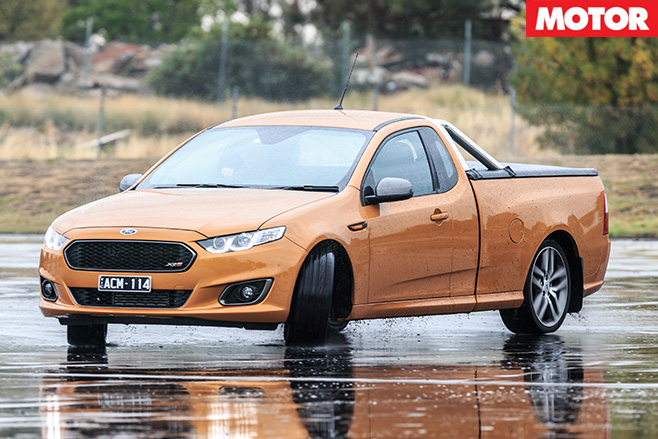
Also, the seating position wasn’t going to be mentioned, as our dislike of the high driver’s seat is well known and it’s not going to change now! That was until a chance drive in MOTOR photographer Nathan Jacob’s BF II Fairmont. While the seat in that was also high, the wheel could be adjusted much higher than is possible in FG-series cars for a much more comfortable driving position – it’s a shame Ford changed it.
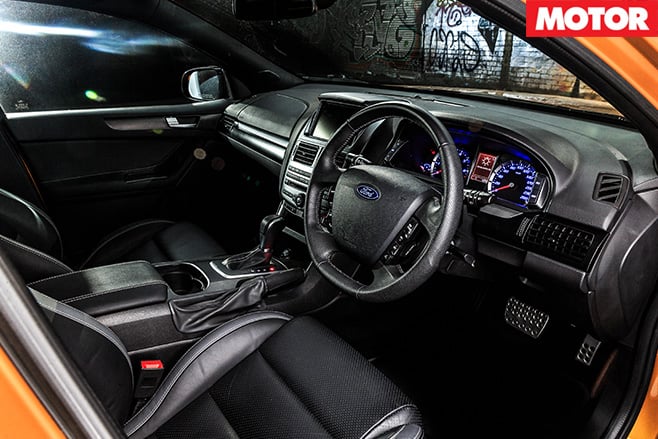
The lack of sat-nav feels a bit cheap at 40 grand, but the reversing camera is worth its weight in gold in a vehicle severely lacking in rearward visibility – parallel parking the similarly-challenged Ford is largely an exercise in guesswork.
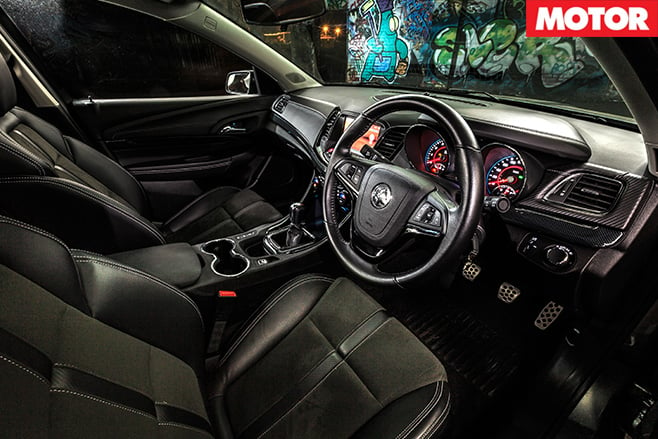
On the flipside, it makes the Holden something of a sleeper, as the performance is anything but dated. It’s difficult to keep perspective when we live in a time of 400kW-plus sedans and hot hatches that rocket to 100km/h in less than five seconds, but the 270kW/530Nm 6.0-litre V8 in the nose of the SS is still a potent device.
It needs plenty of revs to give its best, but once it’s singing there’s easily enough grunt to overwhelm the rear tyres, wet or dry.
It would be nice if it sang a bit louder, though. Sink the slipper and your reward is more of a muted hum than a fearsome roar. Experience with lightly-tuned Commodores has shown us that even if they’re not that much faster, the sharper response and extra volume make them much more fun to drive. Regardless, 0-100km/h in 5.56sec and a 13.77sec quarter mile at 169.09km/h are some of the fastest numbers that have ever flashed up in an SS – sedan or ute.
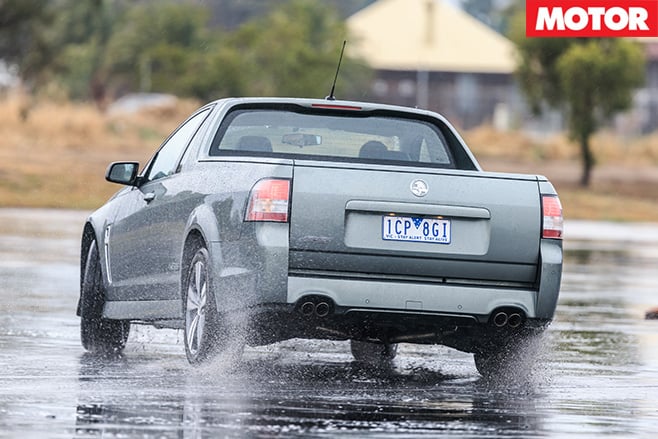
Without over-analysing it, there are a couple of possible explanations for the Blue Oval’s superiority. Firstly, the Falcon’s longer ratios mean it crosses the quarter mile at the top end of third, whereas the Holden requires a shift to fourth.
Secondly, the Falcon was an auto and the SS a manual – Holden ’boxes are much friendlier than they used to be, but even the world’s fastest gearchanger is going to lose a tenth or two, particularly on the tricky two-three shift.
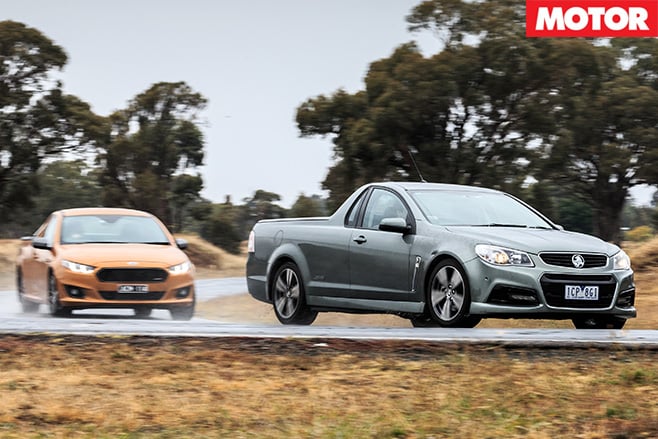
There is a small amount of lag, but that’s simply the turbo taking a breath before unleashing a tidal wave of shove. And tidal wave is the appropriate metaphor; the boost doesn’t arrive violently, in the manner of an early WRX, instead it swells, the acceleration a steady but irrepressible force.
Traction is much stronger than you’d expect in the dry, but in the wet the XR6T will easily break into wheelspin at almost any speed in the first three gears.
Thankfully, it’s extremely predictable to catch, which is just as well given the effect filming drag strip video had on the rear tyres of our test car. On the wide expanses of DECA’s saturated skidpan, anticipating when the boost is going to arrive to spit the car sideways takes some acclimatisation, but with a bit of practice it can be slid around on the lock stops with abandon.
A long wheelbase and plenty of steering lock make the XR6 Turbo a natural drifter.

That said, while the Ford is more predictable once sideways, it can be difficult to sense when it’s going to happen, like when the rear wheels flare up over DECA’s infamous road course hump at 100km/h – new underwear, please. Its steering, too, can’t match the accuracy of the Holden’s, though this MY14 SS has the annoying on-centre deadness that seems to have been improved in MY15 cars.
Up until this point the two contenders have been evenly matched, trading punches and heading for what looked like a points decision. On the public road, however, the two begin to diverge and it’s the Holden that demonstrates its superiority.
The Ford is hamstrung by its commercial origins, with the leaf-sprung rear end unable to cope with bumps, resulting in a very poor unladen ride. The seats are big and comfy, but occupants are constantly jostled and thrown around over bumps.
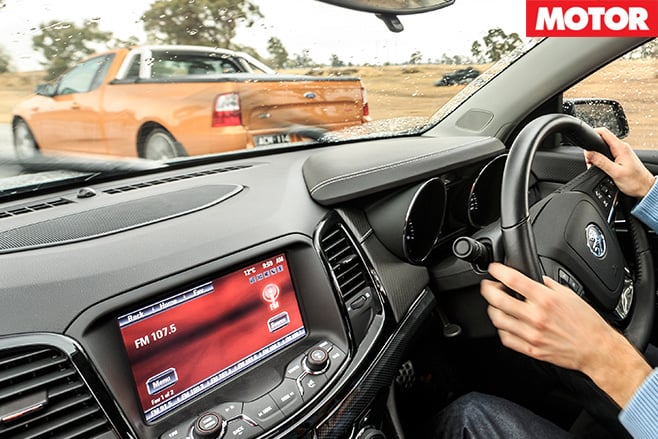
Choosing a manual Ford raises this to 550kg, but lowers the towing capacity from 2300kg to 1200kg, whereas the Holden can tow 1600kg auto or manual. Both cars, however, are severely underbraked for heavy towing – it’s their biggest weakness.
The XR6 Turbo is a surprise packet. It’s a flawed car, and has changed little since the FG’s introduction in 2008, but it’s also a likeable one. Its combination of practicality and straight-line pace means it will appeal to more than just those with Blue Oval tattoos. And, starting from $38,110, you won’t go faster for less.
It’s a blunt instrument, and arguably overpowered, but that makes it exciting in a way that few cars manage these days.
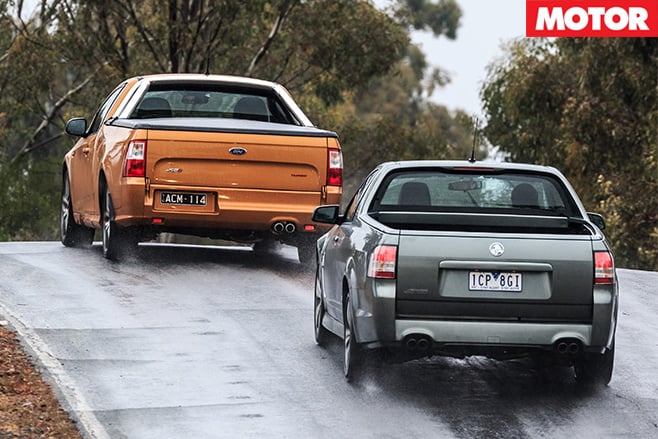
Sadly, in a couple of years’ time we won’t have the choice, as our home-grown utes will be gone and we’ll be left hoping Ford puts a V8 in the Ranger or Volkswagen fits a Golf R donk in the Amarok. It might not yet be clear how we’ll continue the uniquely Australian tradition of high-performance utes, but if history is anything to go by, we’ll think of something.
| u00a0 | FORD XR6T UTE | HOLDEN SS UTE |
| Body | 2-door, 2-seat ute | 2-door, 2-seat ute |
| Drive | rear-wheel | rear-wheel |
| Engine | 3984cc inline-6, DOHC, 24v, turbo | 5967cc V8, OHC, 16v |
| Bore/Stroke | 92.25 x 93.31mm | 101.6 x 92.0mm |
| Compression | 8.8:1 | 10.4:1 |
| Power | 270kW @ 5250rpm | 270kW @ 5600rpmu00a0 |
| Torque | 533Nm @ 2000-5250rpm | 530Nm @ 4400rpmu00a0 |
| Power/Weight | 147kW/tonne | 156kW/tonne |
| Transmission | 6-speed auto | 6-speed manual |
| Weight | 1832kg | 1729kg |
| Suspension | A-arms, coil springs, anti-roll bar (f); leaf springs (r) | struts, coil springs, stabiliser bar (f); multi-links, coil springs, stabiliser bar (r)u00a0 |
| L/W/H | 5065/1934/1485mm | 5083/1898/1494mm |
| Wheelbase | 3103mm | 3009mm |
| Tracks | 1583/1583mm (f/r) | 1592/1606mm (f/r) |
| Steering | hydraulically-assisted rack-and-pinion | electrically-assisted rack-and-pinion |
| Brakes | 322mm ventilated discs, 2-piston calipers (f); 303mm solid discs, single-piston calipers (r)u00a0 | 321mm ventilated discs, 2-piston calipers (f); 324mm ventilated discs, single-piston floating calipers (r) |
| Wheels | 19 x 8.0-inch (f/r) | 18 x 8.0-inch (f/r) |
| Tyres | 245/36 R19 (f/r); Dunlop Sport Maxx | 245/45 R18 (f/r); Bridgestone Potenza RE050A |
| Price | $39,810 | $39,490 |
| Positives | Stonking engine, turbo acceleration, overpowered in a good way, looks | Chassis balance, playful handling, crisp V8, decent payload |
| Negatives | Crummy ride, unsophisticated handling, brakes underdone | Subtle looks, engine needs more aggro, woeful stoppers |
| u00a0 | 3/5 | 3.5/5 |
Click here to read the full range review of the Holden Ute.


